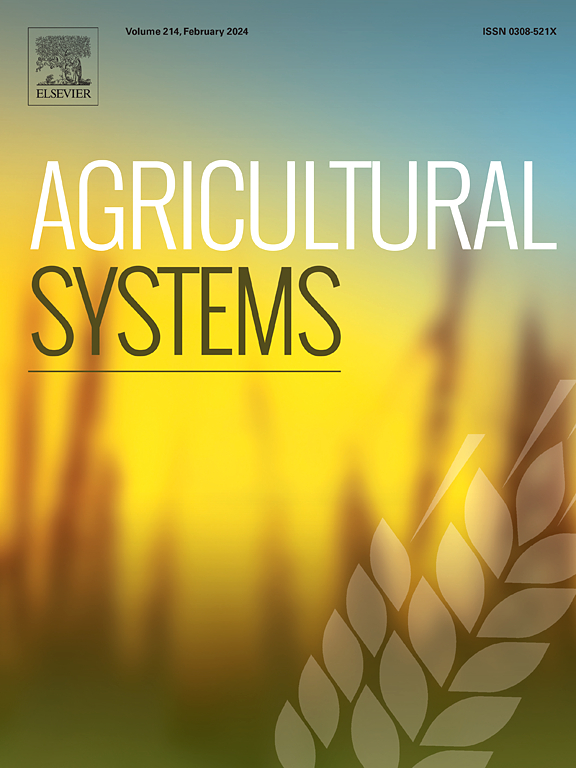Selection of slaughterhouse to deliver fattened pigs depending on growth curves
IF 6.1
1区 农林科学
Q1 AGRICULTURE, MULTIDISCIPLINARY
引用次数: 0
Abstract
Context:
Modern fattening farms require effective interdisciplinary decision-making tools to ensure profitability.
Objective:
This paper introduces a mixed integer linear programming (MILP) - based decision tool, to optimize the transportation strategy selecting the most profitable slaughterhouse and exploring the impact of key factors such as pig prices, feed costs, and mortality rates.
Methods:
The proposed tool is based on a mixed integer linear programming (MILP) model, the pig growth modeling by Gompertz model and the payment grid of different slaughterhouses.
Results and conclusions:
Our findings confirm the selection of the most suitable slaughterhouse significantly enhances the economic outcome, and that the current increment in slaughter weight to about 120 kg leads to a larger fattening period. Piglet mortality did not affect the optimal delivery plan but: for every 1% increase in mortality rate, there was a loss of 0.9 ct €/kg. In addition, four growth curves fit from experimental data are used to compare their optimal marketing strategies. The base case scenario outperformed the official profits reported to the sector by 12.49 ct €/kg liveweight. Pigs with low growth generated losses of -0.42 ct €/kg while medium growth pigs with 4.24 ct €/kg outperformed higher growth pigs (1.29 ct €/kg). The feeding cost advantage makes medium-growth pigs more profitable. The optimal fattening period was 22 weeks except for medium growth pigs (which was from 20 to 21 weeks).
Significance:
With the rise of digital farms and precision livestock farming, Decision Support Systems (DSS) based on accurate growth curves plays a key role in slaughterhouse selection and developing effective marketing strategy, outperforming industry averages.

根据生长曲线选择屠宰场交付肥猪
背景:现代育肥场需要有效的跨学科决策工具来确保盈利能力。目的:介绍一种基于混合整数线性规划(MILP)的决策工具,以优化猪场运输策略,选择最有利可图的屠宰场,并探讨猪价、饲料成本和死亡率等关键因素对猪场运输策略的影响。方法:基于混合整数线性规划(MILP)模型、Gompertz模型的生猪生长模型和不同屠宰场的支付网格。结果和结论:我们的研究结果证实,选择最合适的屠宰场可以显著提高经济效益,并且目前屠宰体重增加到120 kg左右会导致更长的育肥期。仔猪死亡率不影响最佳分娩计划,但死亡率每增加1%,每公斤损失0.9 ct欧元。此外,利用实验数据拟合的四条增长曲线,比较了两家公司的最优营销策略。基本情景情景比官方报告的行业利润高出12.49亿欧元/公斤活重。低生长猪的损失为-0.42 ct€/kg,而中生长猪的损失为4.24 ct€/kg,优于高生长猪(1.29 ct€/kg)。饲养成本优势使中等生长猪更有利可图。除中等生长猪(20 ~ 21周)外,最佳育肥期为22周。意义:随着数字农场和精准养殖的兴起,基于准确生长曲线的决策支持系统(DSS)在屠宰场选择和制定有效的营销策略方面发挥了关键作用,表现优于行业平均水平。
本文章由计算机程序翻译,如有差异,请以英文原文为准。
求助全文
约1分钟内获得全文
求助全文
来源期刊

Agricultural Systems
农林科学-农业综合
CiteScore
13.30
自引率
7.60%
发文量
174
审稿时长
30 days
期刊介绍:
Agricultural Systems is an international journal that deals with interactions - among the components of agricultural systems, among hierarchical levels of agricultural systems, between agricultural and other land use systems, and between agricultural systems and their natural, social and economic environments.
The scope includes the development and application of systems analysis methodologies in the following areas:
Systems approaches in the sustainable intensification of agriculture; pathways for sustainable intensification; crop-livestock integration; farm-level resource allocation; quantification of benefits and trade-offs at farm to landscape levels; integrative, participatory and dynamic modelling approaches for qualitative and quantitative assessments of agricultural systems and decision making;
The interactions between agricultural and non-agricultural landscapes; the multiple services of agricultural systems; food security and the environment;
Global change and adaptation science; transformational adaptations as driven by changes in climate, policy, values and attitudes influencing the design of farming systems;
Development and application of farming systems design tools and methods for impact, scenario and case study analysis; managing the complexities of dynamic agricultural systems; innovation systems and multi stakeholder arrangements that support or promote change and (or) inform policy decisions.
 求助内容:
求助内容: 应助结果提醒方式:
应助结果提醒方式:


